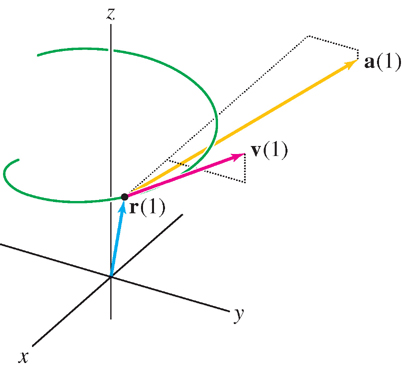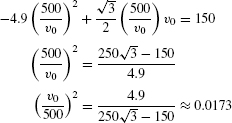13.14 13.5: Motion in Three-Space

In this section, we study the motion of a particle traveling along a path r(t). Recall that

As we have seen, v(t) points in the direction of motion (if it is nonzero), and its magnitude υ(t) = ∥v(t)∥ is the particle’s speed. The acceleration vector is the second derivative r″(t), which we shall denote a(t). In summary,

EXAMPLE 1
Calculate and plot the velocity and acceleration vectors at t = 1 of  . Then find the speed at t = 1 (Figure 2).
. Then find the speed at t = 1 (Figure 2).

Solution

The speed at t = 1 is

If an object’s acceleration is given, we can solve for v(t) and r(t) by integrating twice:

with v0 and r0 determined by initial conditions.
757
EXAMPLE 2
Find r(t) if

Solution We have
v(t) = ∫a(t) dt + v0 = 2ti + 6t2j + v0
The initial condition v(0) = v0 = 7i gives us v(t) = 2ti + 6t2j + 7i. Then we have
r(t) = ∫v(t) dt + r0 = t2i + 2t3j + 7t i + r0
The initial condition r(0) = r0 = 2i + 9k yields
r(t) = t2i + 2t3j + 7ti + (2i + 9k) = (t2 + 7t + 2)i + 2t3j + 9k
Newton’s Second Law of Motion is often stated in the scalar form F = ma, but a more general statement is the vector law F = ma, where F is the net force vector acting on the object and a is the acceleration vector. When the force varies from position to position, we write F(r(t)) for the force acting on a particle with position vector r(t) at time t. Then Newton’s Second Law reads

EXAMPLE 3
A bullet is fired from the ground at an angle of 60° above the horizontal. What initial speed υ0 must the bullet have in order to hit a point 150 m high on a tower located 250 m away (ignoring air resistance)?
Solution Place the gun at the origin, and let r(t) be the position vector of the bullet (Figure 3).

Step 1. Use Newton’s Law.
Gravity exerts a downward force of magnitude mg, where m is the mass of the bullet and g = 9.8 m/s2. In vector form,
F = 〈0, −mg〉 = m〈0, −g〉
Newton’s Second Law F = mr″(t) yields m〈0, −g〉 = mr″(t) or r″(t) = 〈0, −g〉. We determine r(t) by integrating twice:

758
Step 2. Use the initial conditions.
By our choice of coordinates, r0 = 0. The initial velocity v0 has unknown magnitude υ0, but we know that it points in the direction of the unit vector 〈cos 60°, sin 60°〉. Therefore,

Step 3. Solve for υ0.
The bullet hits the point 〈250, 150〉 on the tower if there exists a time t such that r(t) = 〈250, 150〉; that is,

Equating components, we obtain

The first equation yields t = 500/υ0. Now substitute in the second equation and solve, using g = 9.8:

We obtain  .
.
In linear motion, acceleration is the rate at which an object is speeding up or slowing down. The acceleration is zero if the speed is constant. By contrast, in two or three dimensions, the acceleration can be nonzero even when the object’s speed is constant. This happens when υ(t) = ∥v(t)∥ is constant but the direction of v(t) is changing. The simplest example is uniform circular motion, in which an object travels in a circular path at constant speed (Figure 4).

EXAMPLE 4: Uniform Circular Motion
Find a(t) and ∥a(t)∥ for motion around a circle of radius R with constant speed υ.
Solution Assume that the particle follows the circular path r(t) = R〈cos ωt, sin ωt〉 for some constant ω. Then the velocity and speed of the particle are

759
Thus |ω| = υ/R, and accordingly,

The constant ω (lowercase Greek “omega”) is called the angular speed because the particle’s angle along the circle changes at a rate of ω radians per unit time.
The vector a(t) is called the centripetal acceleration: It has length υ2/R and points in toward the origin [because a(t) is a negative multiple of the position vector r(t)], as in Figure 4.